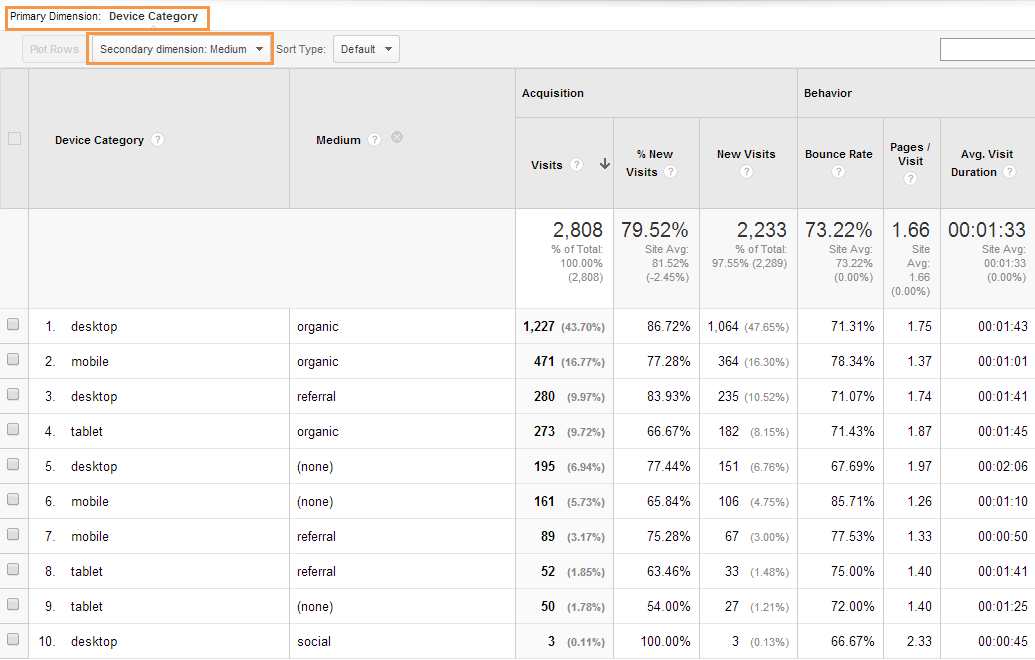Boost Your Data Analysis with Secondary Dimension in Google Analytics
Boost Your Data Analysis with Secondary Dimension in Google Analytics
Blog Article
Make Best Use Of Reporting Precision With Second Dimension in Google Analytics
Understanding exactly how to take full advantage of reporting precision with secondary dimensions in Google Analytics can dramatically boost the depth of insights acquired from information analysis. By integrating additional dimensions purposefully, marketing professionals can uncover hidden patterns and correlations that may not be immediately evident when assessing key metrics alone.
Understanding Secondary Measurements in Google Analytics
Additional dimensions allow users to segment and better explore information beyond the key dimension selected. While the primary dimension may display the complete number of page sights, adding a second dimension such as 'source/medium' can provide understandings right into where the website traffic originated from.
Moreover, recognizing additional measurements is essential for creating extra tailored reports tailored to specific organization objectives. By choosing the right mix of additional and main measurements, experts can uncover patterns, fads, and correlations that could or else continue to be concealed. This nuanced approach to data analysis encourages businesses to make educated decisions based on an extensive understanding of customer habits across numerous measurements.

Exactly How to Use Additional Measurements
When leveraging secondary measurements in Google Analytics, the sensible application includes choosing certain data parameters to further fine-tune insights past the main measurement's extent. To apply additional dimensions effectively, start by accessing the record or dataset where you desire to delve deeper into the information. Remember that additional measurements aid give context and granularity to your key measurement data, enabling you to draw out even more actionable and significant understandings from your Google Analytics reports.
Leveraging Secondary Measurements for Insights
Making use of second measurements in Google Analytics permits for an extra thorough evaluation of information, providing valuable insights past the key dimension's scope. By leveraging additional measurements, users can dig much deeper right into the efficiency metrics of their site or app, revealing surprise patterns and fads that may not be immediately noticeable when only looking at primary dimensions.
One trick advantage of utilizing second dimensions is the ability to sector and filter information extra specifically. This can assist analysts and online marketers much better recognize the habits of particular customer sectors, such as new site visitors versus returning site visitors, or website traffic originating from various geographic locations.
Furthermore, additional dimensions allow customers visit this web-site to contrast and contrast numerous data factors within the same record, offering a much more holistic sight of efficiency (Secondary Dimension in Google Analytics). For instance, coupling the key measurement of touchdown web pages with additional dimensions like tools or demographics can expose which web pages are most effective in involving individuals on different tools or from various group groups.
In significance, leveraging secondary measurements in Google Analytics equips users to extract richer insights from their information, bring about more enlightened decision-making and eventually, improved efficiency.
Ideal Practices for Second Dimensions
When examining information in Google Analytics, including second dimensions successfully boosts the depth of insights obtained from the main metrics. Picking relevant secondary measurements assists in giving context and a more clear understanding of the information being taken a look at.
In addition, it is recommended to limit the number of secondary dimensions used in a single report to avoid overwhelming the analysis with way too much information. Concentrating on a couple of vital secondary measurements at once can lead to even more focused and actionable insights. Additionally, think about trying out various mixes of secondary and key dimensions to uncover unique patterns and patterns that may not be noticeable when looking at the information in seclusion.
Advanced Analysis Techniques With Second Dimensions
Exploring visit our website elaborate data connections via the strategic application of secondary measurements can introduce nuanced understandings that boost the deepness of analysis in Google Analytics. By combining additional measurements with primary information sets, sophisticated evaluation methods can be employed to remove useful information.
In addition, second dimensions can enhance the evaluation of conversion paths by offering extra context. Comprehending the various touchpoints a customer communicates with before converting can be essential in enhancing the customer journey - Secondary Dimension in Google Analytics. By making use of additional dimensions to dig into specifics such as website traffic resources or devices utilized, navigate to this site online marketers can customize strategies to target high-converting networks efficiently
Final Thought

To improve data analysis and gain deeper understandings into individual actions, recognizing additional dimensions in Google Analytics is necessary - Secondary Dimension in Google Analytics. Secondary measurements enable users to segment and better explore information beyond the main measurement picked. While the main dimension might display the complete number of page sights, adding an additional dimension such as 'source/medium' can provide insights into where the website traffic stemmed from.When leveraging additional measurements in Google Analytics, the useful application involves picking details data criteria to further improve insights beyond the key measurement's scope. Bear in mind that additional dimensions aid provide context and granularity to your primary measurement information, enabling you to draw out more actionable and significant insights from your Google Analytics records
Report this page